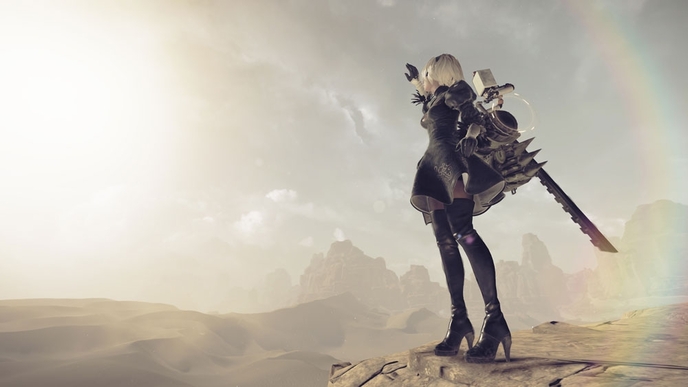
Last weekend I read that Norway will be expanding the World Arctic Archive to include a second doomsday vault, ensuring that historically important data will also be locked away in a secure holding facility close to the North Pole, joining a library of plant seeds held in the Svalbard Global Seed Vault designed to survive an apocalyptic event.
While the second vault is meant to serve as a failsafe in the eventuality of a major catastrophe — natural or man made — the news couldn’t help shake me in a way that’s been happening a lot lately. If the current political climate isn’t some kind of foreshadowing to some dark, coming events, I don’t know what is. And in this present, as various organizations join together to ensure the safety of precious knowledge in the face of certain doom, Nier: Automata’s commentary on the path human destruction only becomes more poignant.
The full Nier storyline is too complex for a quick explanation. The most recent game, Nier: Automata, can be summarized like this: thousands of years into the future aliens invade the Earth forcing humans to escape to the Moon. The humans leave behind an army of humanoid androids to fight on their behalf in a war to reclaim Earth from the extraterrestrial invaders and their own horde of violent machines. After centuries more of fighting, android soldiers 2B and 9S arrive on Earth as yet another pair of reinforcements in this never ending war.
Unbeknownst to either the machine or android armies, the humans and aliens who started the war and created sentient war toys to suffer in their stead, are long extinct, leaving behind an empty Earth where two artificially constructed factions are forced to play out the violence of their creators for all eternity. The cruelty of this irony is the engine that fuels much of the Nier: Automata’s story.
The game tackles humanist themes like war, violence and endless conflict through a cast of painfully humanlike beings and a host of unique gameplay tricks (for example, asking players to replay the game multiple times). Each playthrough unravels even more of the game’s complicated story and reveals the tragedy that plagues these characters as a result of human cruelty.
In particular Nier: Automata understands the meta of videogames and uses it against players in its quest to send an anti-war message. Is it a little on-the-nose that players are asked to explore a world of violence through a pair digital avatars, not unlike the actual androids and machines who are also artificial proxies forced into cruel and violent acts? Nier: Automata is filled with parallels to these conflicts with references and themes running only as deep as your understanding of human history. In a world full of fake humans and machines, thoughts of refugees, proxy wars waged by corporations and imperial powers, and the oncoming repetition of historical tragedy swims all around this beautiful hack-and-slash game.
By the end however, Nier: Automata ultimately argues for hope and redemption in the face of folly. After a grueling 30-plus hours of excavating the depths of human cruelty, the game ends on a prayer that the cycle of destruction might one day end. It’s a beautiful sentiment and something that touched my heart and brought me close to tears. The sadness that followed my playthrough was in knowing that it might be too late for this timeline to end prevent that fate for ourselves.
In one particularly poignant moment, my character came across historical documents that explain how to rebuild a nuclear arsenal. Delivering the documents to your superiors implies that the re-discovered method of mass destruction will be used once again in the android/machine war. However, delivering the documents to a pacifist machine village will ensure that the document is properly destroyed. It’s a moment of hope that’s quickly extinguished by a follow-up question by the pacifist machine leader: will the villagers resent it for giving up the chance to build a nuclear stockpile if these weapons are ultimately used against them?
In one elegant exchange, the world’s current nuclear crisis is beautifully translated into a videogame sidequest. But the reference seems less metaphoric the President of the United States talks about wanting the country’s nuclear arsenal to be “top of the pack;. At that moment the mission seems less like a moment of reflection, and instead as a warning. The whole game feels like a warning.
Nier: Automata imagines a world centuries in the future as ravished by infinite conflict. And while the game builds its narrative around overcoming the base human nature that led to the apocalypse, I fear that our self-destruct sequence is already set in motion (as evidenced by the missiles dropped in Syria). Although the game ultimately argues that release from systemic suffering might not occur in our lifetime, the missed opportunity hurts. Nier: Automata chooses hope, even as it realizes it has little reason to.
It’s a brutal conclusion, but not one that’s easy to swallow, especially given the current events. The predictions of doom are written in every escalating news headline. As Nier: Automata’s message becomes clearer, the tragedy of being too late only intensifies. While I can hope to that some future generation will heed our warnings and learn from our mistakes, we are currently in the middle of our own irrevocable cycle of destruction.
And that’s what makes Nier: Automata even more beautiful and tragic—and all the more painful.
Matthew Kim is a San Francisco-based entertainment reporter who covers all things geek and pop-culture. You can contact him through his Twitter @LawofTD or check out his bylines at Inverse, Waypoint, Polygon, and elsewhere.
